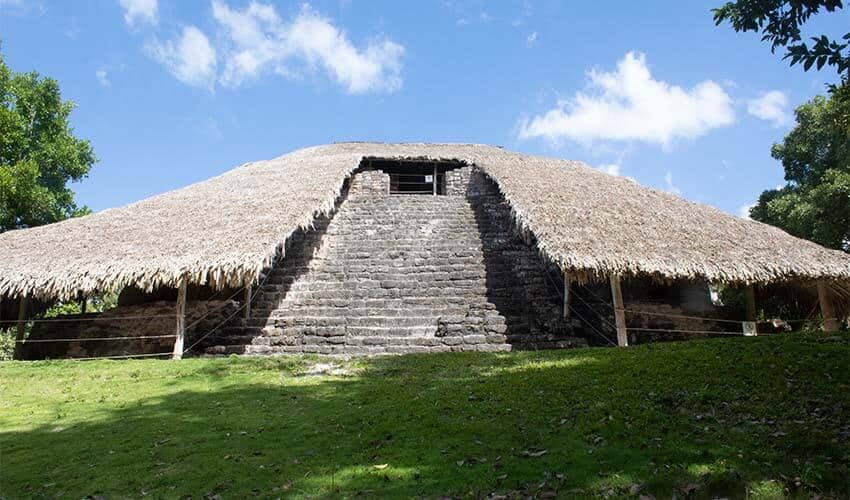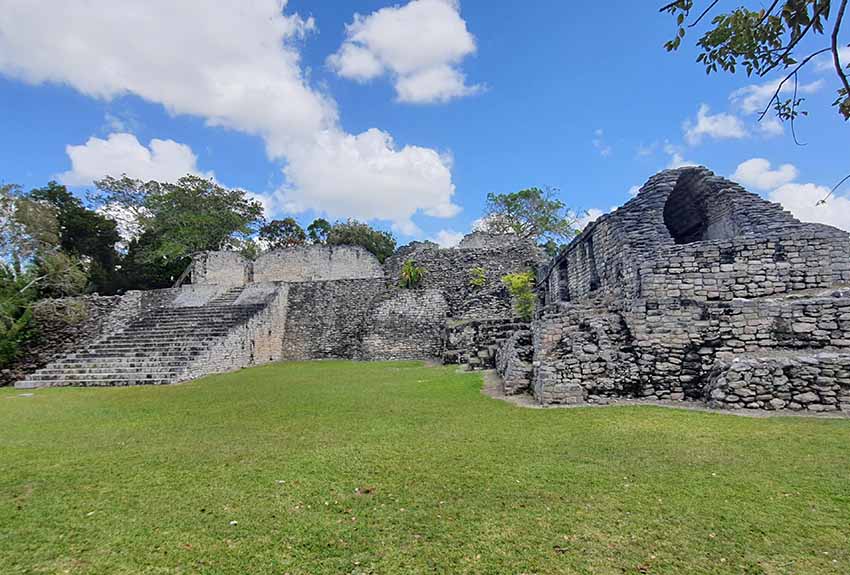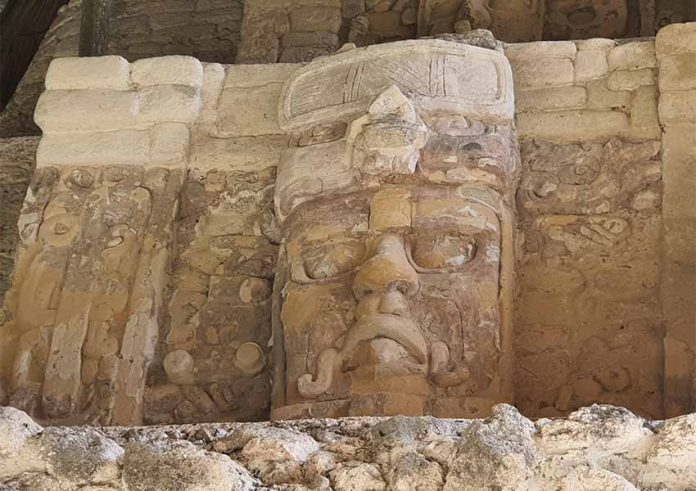Kohunlich may not be as famous as the Yucatán Peninsula’s more well-known archaeological sites, but it is nevertheless a must-see! The display of stucco masks on one of its temples alone will mesmerize you.
You can combine a trip to Kohunlich, located around 68 kilometers from Chetumal, with visits to the archaeological sites Dzibanché and Oxtankah. We visited these sites from Bacalar.
The National Institute of Anthropology and History (INAH) says Kohunlich is derived from a former English name for the site, “Cohoon Ridge,” meaning “hill of corozos,” referring to a type of palm tree. According to INAH, the site’s earliest occupation dates to around 500–300 B.C., and its development occurred during A.D. 600–900. It was eventually abandoned sometime during the 12th or 13th century.
Archaeologist Raymond Merwin first reported finding the site in 1912, and one of the plazas is named after him, but INAH says excavations didn’t begin until the late 1960s. At that time, burials and offerings were also discovered.

The masks, which bear features of the Maya sun god, are probably its biggest attraction, but there are many buildings in various architectual styles here, so expect to spend a few hours visiting — and don’t forget to enjoy the site’s natural beauty, greenery and wildlife.
Once you enter the site, you will see its largest building, called the Acrópolis. It has a notable stairway towards the west. Among other purposes, it is thought to have served as an elite residence.
Make time to see the rooms of the Acropolis’ upper courtyard: some rooms feature platforms that look like resting spaces; they offer beautiful views of the site. Toward the Acrópolis’ southwest is an annex that was a housing complex. It features interesting graffiti in one of the rooms.
The Palace structure, also considered an elite residence, is definitely worth seeing, as is the nearby residential complex, which researchers speculate belonged to important artisans who produced primarily shell-based products.
South of the Acrópolis is a large plaza called the Stelae Plaza, where civic and ceremonial events are believed to have taken place. This is the heart of the site. East of this plaza is the Building of the Stelae, with three stelae – carved stone slabs – on its stairs. West of the plaza is a large building called The King, with ruins of a temple on top. The rear of this building, towards the entrance to the site, is also worth seeing.
South of the Stelae Plaza is the Grandstand, which looks like an ancient version of a present-day grandstand. It has a long platform with a large central stairway. It’s easy to imagine the ancient Maya viewing events in the plaza from these steps.
Next to the Stelae Plaza is Plaza Merwin, named after the archaeologist who first reported finding the site. This plaza is thought to have held smaller ceremonies. A notable structure here is the Building of the Eleven Doors, built on a platform featuring eleven doorway-like apertures.
East of Plaza Merwin is the ball court where the ancient residents played their ball game, which is thought to represent the revolving cycles of life and death.

The jewel of this site is its famous Temple of the Masks, a pyramid structure with a temple on top. This building has a thatched roof, so you can easily keep an eye out for it. There are five well-preserved masks here, but INAH says there were once eight.
The magnificent stucco masks sit on either side of the building’s stairway. They have fascinating features, including nose rings, as well as the remains of original paint. According to INAH, these masks depict real characters with features of the sun god Kinich Ahau. You will not tire of admiring these spectacular ancient creations, allowing you to visualize what a beautifully decorated city it must have been.
The site has more residential buildings worth visiting. Near Plaza Merwin, you’ll find the Pixa’an Complex, which may have been elite residences. But perhaps the more interesting residential structure is the one located towards the south of the site, called “The 27 Steps,” named after its stairway. It is also speculated to have housed elite members of Kohunlich. You can take the stairs to the top, but be sure to climb with care.
In addition to many more structures to see on the site, Kohunlich also allows you to see signs of the water system that the ancient residents built to utilize rainwater. And don’t forget to keep an eye out for birds and other interesting wildlife — like howler monkeys.
Finally, if you’re a big fan of visiting Mexico’s ancient ruins, take advantage of Kohunlich’s convenient location near another fascinating Maya city — Dzibanché, which is only a 45-minute drive away.
Thilini Wijesinhe, a financial professional turned writer and entrepreneur, moved to Mexico in 2019 from Australia. She writes from Mérida, Yucatán. Her website can be found at https://momentsing.com/
